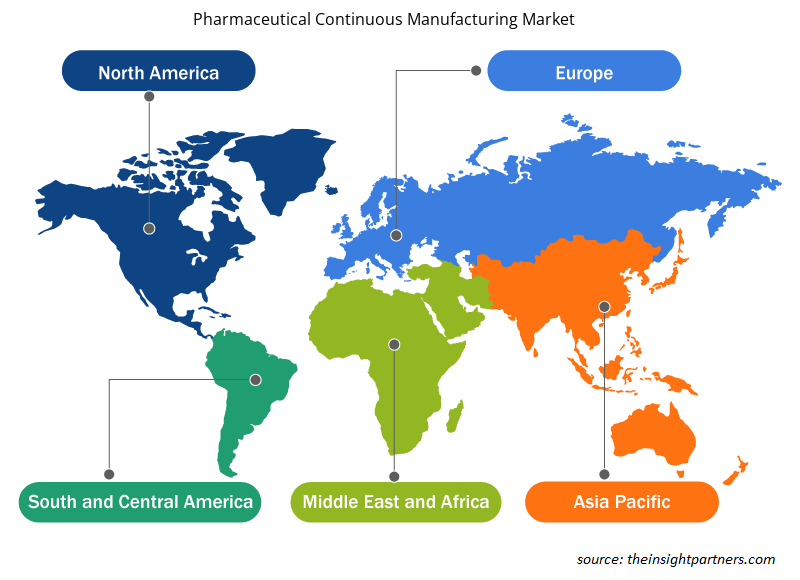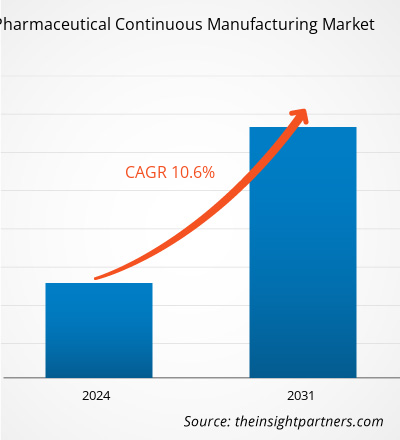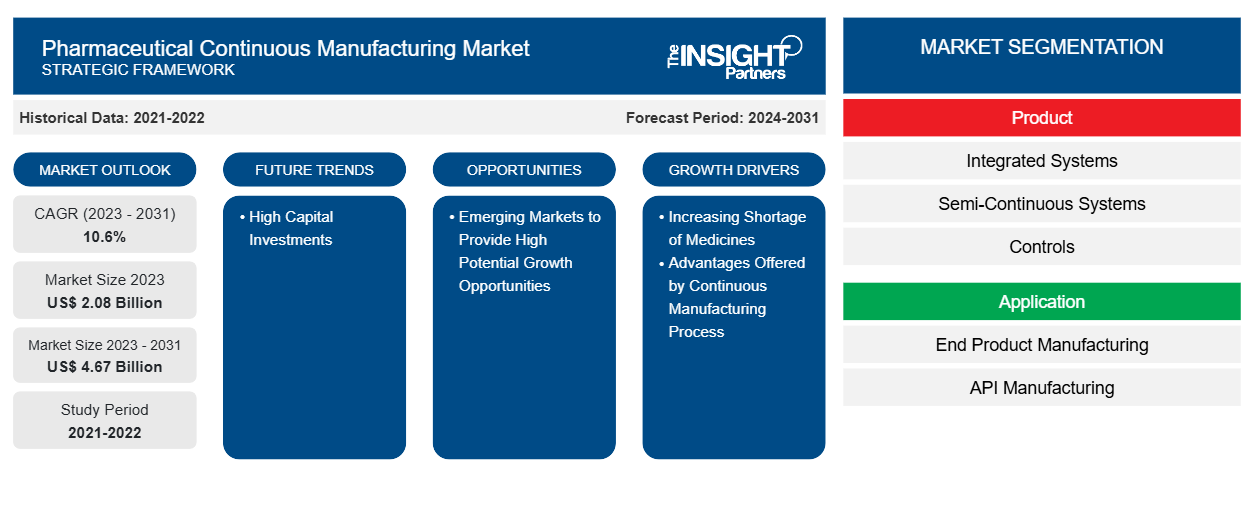제약 연속 제조 시장 규모는 2023년 20억 8,000만 달러에서 2031년 46억 7,000만 달러로 성장할 것으로 예상됩니다. 이 시장은 2023~2031년 동안 10.6%의 CAGR을 기록할 것으로 예상됩니다. 규제 기관의 지원 증가, 계약 및 사내 제조업체의 약물 제조 절차 채택 증가, 연속 제조와 관련된 이점은 시장의 주요 추세로 남을 가능성이 높습니다.
제약 연속 제조 시장 분석
제약 회사는 경쟁 우위를 확보하고 시장에서 앞서 나가기 위해 혁신적인 제조 기술에 끊임없이 투자하고 있으며, 이를 통해 연속 제조 시장을 주도하고 있습니다. 연속 제조를 통해 제약 회사는 생산 공정을 보다 잘 제어할 수 있어 최종 제품의 품질 개선과 일관성에 도움이 되며, 편차, 낭비를 줄이고 재작업 시간과 리콜 비용을 절감할 수 있습니다. 제약 연속 제조는 최종 제품의 품질을 개선하고, 공정 제어를 강화하며, 실시간 릴리스 테스트를 허용할 수 있습니다. 유럽 의약품 기관(EMA)과 미국 식품의약국(FDA)은 제약 산업에서 연속 제조 사용을 점점 더 선호하는 규제 기관입니다. 더욱이 연속 제조는 자동화, 시스템 제어, 데이터 분석 및 공정 분석 기술(PAT)을 통해 제공되는 개선된 공정 모니터링, 제어 및 최적화로 인해 제약 산업에서 더욱 매력적이고 실용적이 되었으며, 이는 시장을 주도합니다.
제약 연속 제조 시장 개요
제약 산업에서 압력을 최소화하고 약물 개발 시간과 비용을 줄이는 실행 가능한 솔루션으로, 최종 제품 품질과 공급을 유지하는 동시에 연속 제조가 널리 사용되고 있습니다. 따라서 이러한 이점으로 인해 연속 제조 시장은 건강한 성장을 목격하고 있습니다. 또한 식품의약국(FDA)에서 연속 제약 제조 시스템 사용을 촉진하기 위한 이니셔티브가 증가하고 있으며, 배치 제조에 비해 연속 제조 시스템의 수많은 이점이 시장 성장을 견인하는 주요 요인 중 일부입니다. 그러나 반면에 제약 연속 제조 시스템의 고비용 구현은 시장 성장을 방해할 가능성이 높습니다.
귀하의 요구 사항에 맞게 이 보고서를 사용자 정의하세요
이 보고서의 일부 또는 국가 수준 분석, Excel 데이터 팩을 포함하여 모든 보고서에 대한 사용자 정의를 무료로 받을 수 있으며 신생 기업 및 대학을 위한 훌륭한 혜택과 할인 혜택을 이용할 수 있습니다.
-
이 보고서의 주요 시장 동향을 알아보세요.이 무료 샘플에는 시장 동향부터 추정 및 예측까지 다양한 데이터 분석이 포함됩니다.
제약 연속 제조 시장 동인 및 기회
시장을 선호하는 연속 제조 공정이 제공하는 이점
제약 연속 제조는 생물학 및 유연한 제조 대안에 대한 수요가 증가함에 따라 채택되고 중요성이 커지고 있습니다. 연속 제조 절차로 전환하는 회사는 FDA로부터 신속하게 승인을 받고 있습니다. 연속 제조 공정은 시간 효율성, 에너지 요구 및 낭비 감소, 생산성 증가를 포함한 많은 이점을 제공합니다. 또한 이 공정은 제조 공정에 소수의 사람이 참여하기 때문에 인적 오류의 위험을 줄입니다. 따라서 연속 제조가 제공하는 앞서 언급한 이점으로 인해 시장은 향후 몇 년 동안 성장할 것으로 예상됩니다.
신흥 시장은 높은 잠재 성장 기회를 제공합니다
아시아 태평양 및 중부 및 남부와 같은 지역에서 생물제약 산업을 위한 매력적인 아웃소싱 위치가 부상하고 있습니다. 중국과 인도는 아시아 태평양 지역의 시장 성장을 주도하는 중요한 요인인 낮은 제조 및 운영 비용을 제공합니다. 중국과 인도는 두 나라 모두에서 생물제약 산업의 최근 성장으로 인해 시장에 대한 긍정적인 미래 전망을 나타냅니다. 2020년 1월, WuXi AppTec의 자회사인 STA Pharmaceutical Co., Ltd.는 중국에 새로운 대규모 올리고뉴클레오티드 활성 제약 성분(API) 제조 시설을 열었습니다. 따라서 생물제약 산업에 적합한 신흥 시장은 제약 연속 제조 시장에서 높은 잠재적 성장 및 수익 창출원 역할을 할 가능성이 높습니다.
제약 연속 제조 시장 보고서 세분화 분석
제약품 연속 제조 시장 분석에 기여한 주요 세그먼트는 제품, 응용 분야 및 최종 사용자입니다.
- 제품을 기준으로, 제약 연속 제조 시장은 통합 시스템, 반연속 시스템 및 제어로 세분화됩니다. 통합 시스템 세그먼트는 2023년에 가장 큰 시장 점유율을 차지했으며 예측 기간 동안 가장 높은 CAGR을 기록할 것으로 예상됩니다.
- 응용 프로그램별로 시장은 최종 제품 제조와 API 제조로 나뉩니다 . 최종 제품 제조 부문은 고체 투여 제조와 액체 투여 제조로 더 나뉩니다. 최종 제품 제조 부문은 2023년에 시장에서 가장 큰 점유율을 차지했습니다. 그러나 API 제조 부문은 2021~2031년 동안 가장 높은 CAGR을 기록할 것으로 예상됩니다.
- 최종 사용자를 기준으로, 제약 연속 제조 시장은 풀 스케일 제조 회사와 R&D 부서로 나뉩니다. 풀 스케일 제조 부문은 2023년에 가장 큰 시장 점유율을 차지했으며 예측 기간 동안 가장 높은 CAGR을 기록할 것으로 예상됩니다.
지역별 제약 연속 제조 시장 점유율 분석
제약품 연속 제조 시장 보고서의 지리적 범위는 주로 북미, 아시아 태평양, 유럽, 중동 및 아프리카, 남미 및 중부 아메리카의 5개 지역으로 나뉩니다.
북미는 제약 연속 제조 시장을 지배해 왔습니다. 북미에서 제약 연속 제조 시장이 성장하게 된 요인은 FDA가 일괄 제조보다 연속 제조 사용을 장려하기 위한 지원이 증가하고, 이 지역에서 약물 부족이 증가하고, 연속 제조 공정을 구축하기 위한 초기 투자를 감당할 수 있는 제약 거대 기업이 존재하기 때문입니다. 미국의 대부분 산업은 수십 년 동안 연속 제조 공정을 도입했습니다. 미국은 연속 제조 절차를 도입하는 제약 기업의 증가, 제조 기술 분야의 발전, 이러한 설비가 생산량을 확대하기 위해 제공하는 효율성과 같은 요인으로 인해 북미에서 지배적인 위치를 차지하고 있습니다. 또한, 미국 FDA는 제약 산업 내에서 미국에서 연속 제조를 장려하기 위한 다양한 이니셔티브를 수행했습니다.
제약 연속 제조 시장 지역 통찰력
Insight Partners의 분석가들은 예측 기간 동안 제약 연속 제조 시장에 영향을 미치는 지역적 추세와 요인을 철저히 설명했습니다. 이 섹션에서는 북미, 유럽, 아시아 태평양, 중동 및 아프리카, 남미 및 중미의 제약 연속 제조 시장 세그먼트와 지리에 대해서도 설명합니다.

- 제약 연속 제조 시장에 대한 지역별 특정 데이터를 얻으십시오
제약 연속 제조 시장 보고서 범위
| 보고서 속성 | 세부 |
|---|---|
| 2023년 시장 규모 | 20억 8천만 달러 |
| 2031년까지 시장 규모 | 46억 7천만 달러 |
| 글로벌 CAGR (2023-2031) | 10.6% |
| 역사적 데이터 | 2021-2022 |
| 예측 기간 | 2024-2031 |
| 다루는 세그먼트 |
제품별로
|
| 포함된 지역 및 국가 |
북아메리카
|
| 시장 선도 기업 및 주요 회사 프로필 |
|
시장 참여자 밀도: 비즈니스 역학에 미치는 영향 이해
제약 연속 제조 시장은 소비자 선호도의 변화, 기술 발전, 제품의 이점에 대한 인식 증가와 같은 요인으로 인해 최종 사용자 수요가 증가함에 따라 빠르게 성장하고 있습니다. 수요가 증가함에 따라 기업은 제품을 확장하고, 소비자의 요구를 충족하기 위해 혁신하고, 새로운 트렌드를 활용하여 시장 성장을 더욱 촉진하고 있습니다.
시장 참여자 밀도는 특정 시장이나 산업 내에서 운영되는 회사나 기업의 분포를 말합니다. 주어진 시장 공간에 얼마나 많은 경쟁자(시장 참여자)가 존재하는지 그 규모나 총 시장 가치에 비해 나타냅니다.
제약 연속 제조 시장에서 운영되는 주요 회사는 다음과 같습니다.
- GEA그룹
- 코페리온 GmbH
- 게리케 AG
- 글라트 GmbH
- 호소카와 마이크론 그룹
- 먼슨 머시너리 주식회사
면책 조항 : 위에 나열된 회사는 어떤 특별한 순서에 따라 순위가 매겨지지 않았습니다.

- 제약 연속 제조 시장 주요 기업 개요를 알아보세요
제약 연속 제조 시장 뉴스 및 최근 개발
제약 연속 제조 시장은 1차 및 2차 연구 이후의 정성적, 정량적 데이터를 수집하여 평가합니다. 여기에는 중요한 기업 간행물, 협회 데이터 및 데이터베이스가 포함됩니다. 제약 연속 제조 시장의 몇 가지 개발 사항은 다음과 같습니다.
- 한국에 본사를 둔 계약 개발 및 생산 기관(CDMO)인 SK 바이오사이언스는 한국 경상북도 안동에 있는 L하우스 백신 제조 시설을 약 4,200m2 확장하는 공사를 시작했습니다. 이 시설은 SK 바이오사이언스와 사노피가 공동으로 개발하는 폐렴구균 접합백신 후보물질 GBP410의 생산 기지가 될 예정입니다. (SK 바이오사이언스, 보도자료, 2024년 3월)
- 미국에 본사를 둔 필수 의약품 공익 기업인 플로우 코퍼레이션(Phlow Corp.)은 버지니아 커먼웰스 대학교(VCU)의 Medicines for All Institute와 AMPAC Fine Chemicals와 전략적 제휴를 맺어 소분자 의약품에 대한 계약 연속 제조 연구 개발(R&D) 서비스를 제공한다고 발표했습니다. 견고하고 성장하는 내부 역량 외에도, 플로우의 확립되고 혁신적이며 경험이 풍부한 전략적 파트너 네트워크는 최첨단 기술과 고유한 산업 통찰력을 사용하여 모든 개발 단계에서 소분자 활성 제약 성분(API) 및 등록된 시작 물질(RSM)에 대한 고품질의 미국 기반 고급 제조 솔루션을 제공할 것입니다. (플로우 코퍼레이션, 뉴스, 2022년 3월)
제약 연속 제조 시장 보고서 범위 및 제공물
"제약 연속 제조 시장 규모 및 예측(2021-2031)" 보고서는 아래 영역을 포괄하는 시장에 대한 자세한 분석을 제공합니다.
- 범위에 포함된 모든 주요 시장 세그먼트에 대한 글로벌, 지역 및 국가 수준의 제약 연속 제조 시장 규모 및 예측
- 제약 연속 제조 시장 동향 및 동인, 제약 및 주요 기회와 같은 시장 역학
- 자세한 PEST 및 SWOT 분석
- 주요 시장 동향, 글로벌 및 지역 프레임워크, 주요 업체, 규정 및 최근 시장 개발 사항을 포괄하는 제약 연속 제조 시장 분석
- 시장 집중도, 히트맵 분석, 유명 업체 및 제약 연속 제조 시장의 최근 개발 사항을 포함하는 산업 환경 및 경쟁 분석
- 자세한 회사 프로필
- 과거 분석(2년), 기준 연도, CAGR을 포함한 예측(7년)
- PEST 및 SWOT 분석
- 시장 규모 가치/거래량 - 글로벌, 지역, 국가
- 산업 및 경쟁 환경
- Excel 데이터세트
최근 보고서
사용 후기
구매 이유
- 정보에 기반한 의사 결정
- 시장 역학 이해
- 경쟁 분석
- 고객 인사이트
- 시장 예측
- 위험 완화
- 전략 기획
- 투자 타당성 분석
- 신흥 시장 파악
- 마케팅 전략 강화
- 운영 효율성 향상
- 규제 동향에 발맞춰 대응























 무료 샘플 받기 - 제약 연속 제조 시장
무료 샘플 받기 - 제약 연속 제조 시장